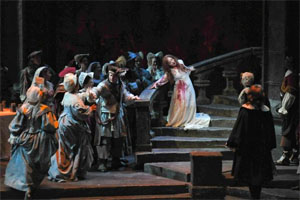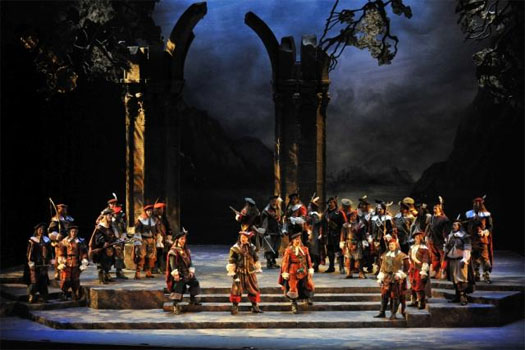In a year of cutbacks and budget crises, the Dallas Opera proves once again, with the current production of Donizetti’s Lucia di Lammermoor at Winspear Opera House, that the ability to cast great singers is that company’s single greatest asset. As so often in the past, the combination of instinct and skill—the eye and ear for a great performer—on the part of the folks in charge resulted in the American premiere of a singer likely to enter the ranks of the great artists of our time.
The singer in question, Romanian soprano Elena Mosuc, portrayed a Lucia on edge, even from her first appearance on the stage, traumatized by a dysfunctional and decayed family, longing to be rescued but clearly doomed already. Moscu’s voice is clear, smooth, flexible, naturally attractive and clearly substantial. The vocal acrobatics assigned to this notoriously difficult role come to her naturally, right up to the horrifying and fascinating moment at which she—and the audience with her—fall under the spell of an imagined, distant reality.

Mosuc’s version of Lucia was beautifully supported vocally by American tenor Bryan Hymel as Edgardo, with Italian baritone Luca Grassi as Enrico and American bass Jordan Bisch as Raimondo. Hymel in particular owned up impressively in a role that demands as much energy as that of Lucia, carrying off the different but equally challenging task of sustaining drama in this opera’s long denouement.
The late Henry Bardon’s sets, designed for Dallas Opera in 1972, strike an appropriate balance between boxy realism and the overpowering symbolism that seduce some designers (I recall an unfortunate Lucia at the Met a few years back staged amidst incongruous giant keyboards and boulders). Massive ruined columns and an echt romantic landscape painting for backdrop evoke the spirit of early romanticism, clearly attuned to the longings and ideals of the age of Donizetti and Walter Scott. Likewise, the late Peter Hall’s lavish costumes bow toward a time and a place (late seventeenth-century Scotland) in which the fashion outlook among even the aristocracy must have been somewhat bleak, but lean more strongly toward a certain agreeable level of color and idealization suited to a nineteenth-century opera, and a twenty-first-century audience.

Stage director Garnett Bruce generally succeeded in creating the necessary web of intrigue and complex relationships among the principal characters on the stage. His treatment of the chorus, which can tend to clump around from one stand-here-and-sing post to another in a piece like Lucia, was less successful. In Lucia, as in most operas, the chorus must be positioned in a way that appears natural and yet communicates literary and symbolic aspects of the drama. That was not, unfortunately, the case during much of this production (albeit the complete exit of the chorus for the main portion of the mad scene was a convincing touch).
Music director Graeme Jenkins once again demonstrated an almost magic touch with the music of Donizetti, this time leaning toward a big-orchestra, big-hall approach to a score which, while clearly related to the early years of romanticism, was contemporary with Berlioz as well as early Wagner and early Verdi. Jenkins clearly understands how to place Donizetti acoustically within a fairly large modern theater, as well as historically and philosophically within the complex overlapping styles of the middle nineteenth century. His readings of Donizetti have been, for this listener, revelatory. I’ll admit that, thanks to Jenkins, my attitude toward this particular composer has progressed from “Oh, Donizetti,” to “Ah! Donizetti!”
Photos: Karen Almond for the Dallas Opera





